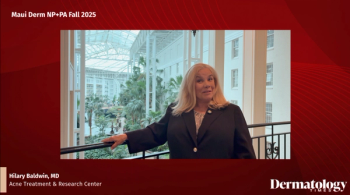
National Rosacea Society Conducts Survey on Persistent Facial Redness
Survey participants state persistent facial redness is one of the most frustrating rosacea symptoms.
The National Rosacea Society (NRS) asked rosacea patients to participate in a survey1 sponsored by EPI Health, a Novan company. Many patients noted that persistent facial redness is one of the toughest rosacea symptoms to manage. Two-thirds of survey participants reported having redness flare-ups more than once a week. Facial redness is one of the most commonly recognized features of rosacea. Facial redness should be considered in treatment options, as it plays a role in aesthetic appearance.
According to survey results, out of the 986 participants with rosacea:
- 77% reported they have experienced persistent facial redness
- 61% developed bumps and pimples
- 53% had visible facial blood vessels
- 46% experienced burning, stinging, and itching
- 43% had red, irritated, or watery eyes related to ocular rosacea
- 27% reported having a red or swollen nose or thickened skin due to phymatous changes
Persistent facial redness was the most bothersome symptom across the survey. Approximately 30% of survey participants said that other symptoms such as pimples and bumps bothered them the most. More than half of survey participants reported that their rosacea and persistent facial redness affect their self-esteem. Many patients worry that their increased redness will draw attention in public. More than half (57% ) of participants said they were unhappy with their appearance due to rosacea, and 40% said they avoid the sun and outdoor activities. Only 4% of the participants stated that rosacea redness did not affect their daily lives.
“The results of this survey are eye-opening for us as dermatologists. It demonstrates that persistent redness is a major cosmetic concern among patients with rosacea. Clearly, it’s important to discuss treatment options including lasers that can be used for reducing facial redness,” said Patricia Farris, MD, co-founder and chief medical officer of RegimenMD in Houston, Texas.
To combat facial redness, effective treatment options must be discussed with rosacea patients. When asked about treatment plans, 80% of survey participants reported that they had tried topical, oral, and laser/light therapy options. Additionally, 12% of patients using topical medication stopped application completely. Close to 20% of patients taking oral medication also completely stopped taking the prescribed medication. Reasons for discontinuing topical or oral treatment include unpleasant adverse events, cost, convenience, and lack of results.
With multiple treatment options available, dermatologists and patients must work together to find a tailored solution that will create better adherence rates.
Reference:
- Persistent facial redness is the most common and bothersome sign of rosacea, survey finds. Rosacea.org. Accessed August 15, 2022. https://www.rosacea.org/blog/2022/august/persistent-facial-redness-is-the-most-common-and-bothersome-sign-of-rosacea-survey-finds
Newsletter
Like what you’re reading? Subscribe to Dermatology Times for weekly updates on therapies, innovations, and real-world practice tips.

















